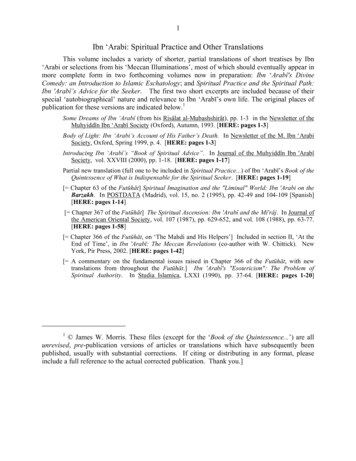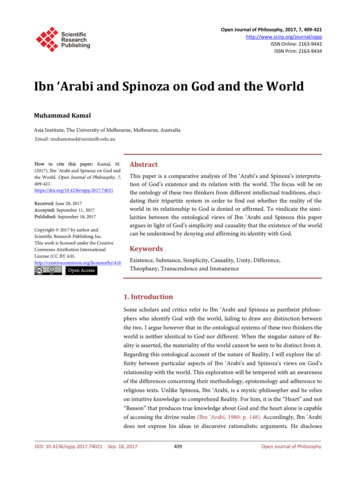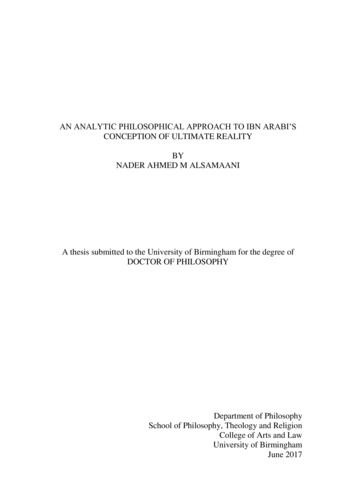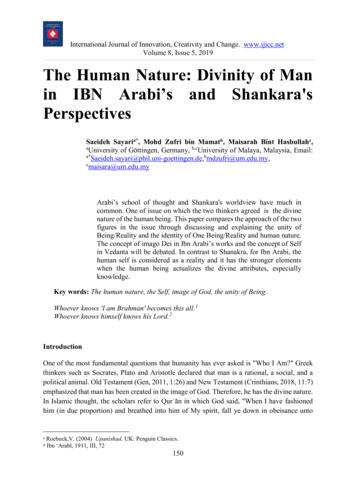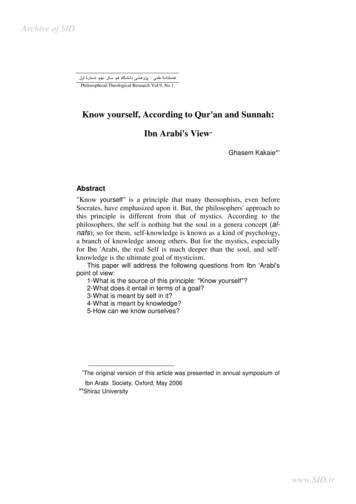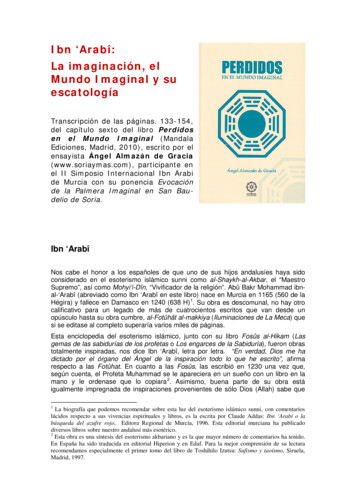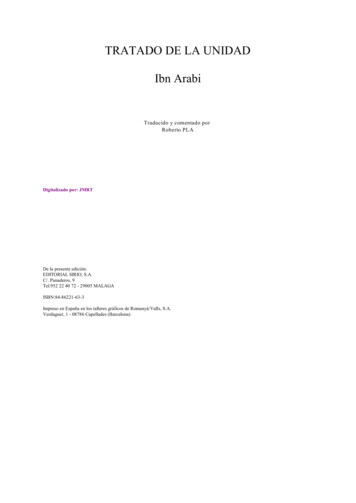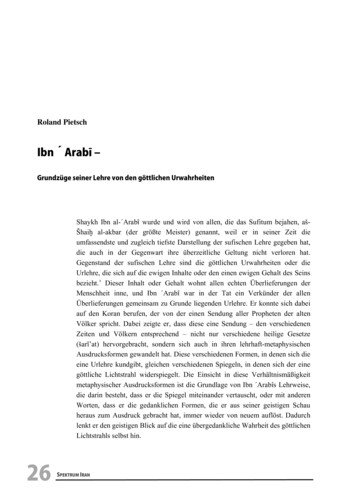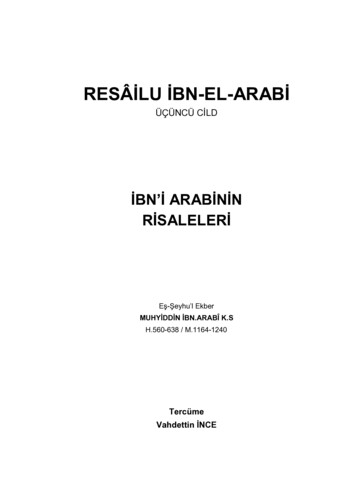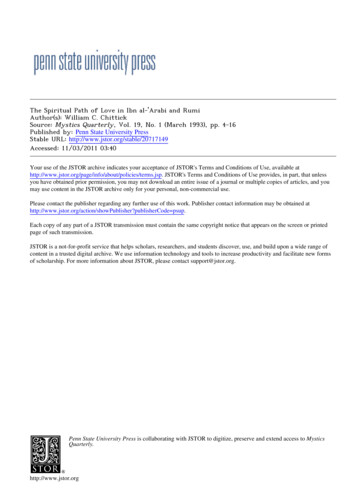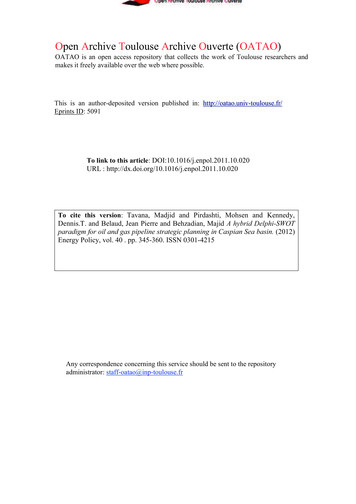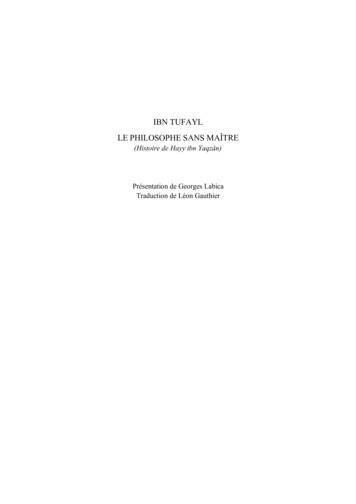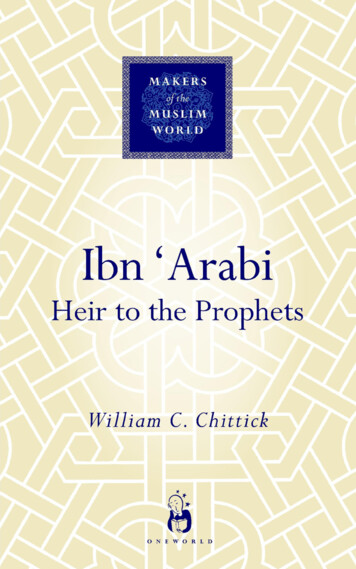
Transcription
Prelims.04925/02/200510:48 AMPage iMAKERSof theMUSLIMWO R L DIbn ‘Arabi“This is a fine book which will make an excellent addition to thesecondary literature on Ibn ‘Arabi currently on the market.Few authors working today can matchWilliam Chittick’s knowledgeand understanding of Ibn ‘Arabi and it is fortunate thathe has written a book that makes Ibn ‘Arabi’s complex worldviewavailable in a relatively short format.”SHAHZAD BASHIR, ASSISTANT PROFESSOR OF RELIGION,CARLETON COLLEGE, MINNESOTA
Prelims.04925/02/200510:48 AMPage iiSELECTION OF TITLES IN THE MAKERS OFTHE MUSLIM WORLD SERIESSeries editor: Patricia Crone,Institute for Advanced Study, Princeton‘Abd al-Malik, Chase F. RobinsonAbd al-Rahman III, Maribel FierroAbu Nuwas, Philip KennedyAhmad ibn Hanbal, Christopher MelchertAhmad Riza Khan Barelwi, Usha SanyalAl-Ma’mun, Michael CoopersonAl-Mutanabbi, Margaret LarkinAmir Khusraw, Sunil SharmaEl Hajj Beshir Agha, Jane HathawayFazlallah Astarabadi and the Hurufis, Shazad BashirIbn ‘Arabi,William C. ChittickIbn Fudi,Ahmad DallalIkhwan al-Safa, Godefroid de CallatayShaykh Mufid,Tamima Bayhom-DaouFor current information and details of other books in theseries, please visit uslim-world.htm
Prelims.04925/02/200510:48 AMPage iiiMAKERSof theMUSLIMWO R L DIbn ‘ArabiHeir to the ProphetsWILLIAM C. CHITTICK
Prelims.04903/03/20054:54 PMPage ivIBN ‘ARABIOneworld Publications(Sales and editorial)185 Banbury RoadOxford OX2 7AREnglandwww.oneworld-publications.com William C. Chittick 2005All rights reservedCopyright under Berne ConventionA CIP record for this title is availablefrom the British LibraryISBN 1–85168–387–9Typeset by Jayvee, IndiaCover and text design by Design DeluxePrinted and bound in India by Thomson Press Ltdon acid-free paperNL08
Prelims.04925/02/200510:48 AMPage vCONTENTSINTRODUCTION 1Ibn ‘Arabi’s Life 4Abbreviations Used in the Text 91THE MUHAMMADAN INHERITANCE 11Inheritance 12Opening 14The Muhammadan Seal 16Reading the Qur’an 17Understanding God 18Knowing Self 20God’s Wide Earth 22The Inheritor 232THE LOVER OF GOD 27Assuming the Traits of the Names 29The Divine and Human Form 31Imperfect Love 323THE DIVINE ROOTS OF LOVE 35Wujud 36The Nonexistent Beloved 38The Entities 40The Genesis of Love 42Love’s Throne 44Human Love 45Felicity 46v
Prelims.04925/02/200510:48 AMPage vivi IBN ‘ARABIPoverty 47Perfection 494THE COSMOLOGY OF REMEMBRANCE 53Remembrance 53Prophecy 55The Book of the Soul 57The Breath of the All-Merciful 58Knowledge of the Names 61All-Comprehensiveness 62Achieving the Status of Adam 63The Perfect Servant 64The House of God 665KNOWLEDGE AND REALIZATION 69Knowledge 70Benefit 72The Form of God 74Reliable Knowledge 75Following Authority 77Realization 78The Ambiguity of Creation 80Giving Things their Haqq 81The Rights of God and Man 83The Soul’s Haqq 846TIME, SPACE, AND THE OBJECTIVITY OFETHICAL NORMS 87The Methodology of Realization 87Time and Space 91Location 92Time 93Eternity 94
Prelims.04925/02/200510:48 AMPage viiCONTENTS viiConstant Transformation 96Ethics 97Lost in the Cosmos 997THE IN-BETWEEN 101Relativity 102The Worldview of In-Betweenness 103Cosmic Imagination 105The Soul 108The Soul’s Root 109Controversies 111The Gods of Belief 1128THE DISCLOSURE OF THE INTERVENINGIMAGE 115Self-Awareness 117Death 118Love 1199THE HERMENEUTICS OF MERCY 123Interpreting the Qur’an 124Good Opinions of God 126The Return to the All-Merciful 128The Mercy of Wujud 130Mercy’s Precedence 131Essential Servanthood 134Primordial Nature 135Sweet Torment 136Constitutional Diversity 139Surrender 141Resources 145Index 147
Prelims.04925/02/200510:48 AMPage viii
Intro.04925/02/200510:50 AMPage 1I N T RO D U C T I O Norn in Spain in 1165, Ibn ‘Arabi is at once the most influential and the most controversial Muslim thinker to appearover the past nine hundred years.The Sufi tradition looks backupon him as “the greatest master” (ash-shaykh al-akbar), bywhich is meant that he was the foremost expositor of its teachings. Modern scholarship is rightly skeptical about grandiosetitles, but there is plenty of evidence to suggest that this specifictitle is not out of line. On the quantitative side, Ibn ‘Arabi’s massive al-Futuhat al-makkiyya (“The Meccan Openings”) providesmore text than most prolific authors wrote in a lifetime.Manuscripts of several hundred other works are scattered inlibraries,and scores of books and treatises have been published.But “greatness” is not to be judged by bigness, so we clearlyneed to look at the contents of all those pages. Probably no onehas ever read everything Ibn ‘Arabi wrote, and few specialistswould even claim to have read the whole Futuhat. Even so,“reading” is one thing, “understanding” something else. Ibn‘Arabi has always been considered one of the most difficult ofauthors.This is due to many factors,not least extraordinary erudition, consistently high level of discourse, constantly shiftingperspectives, and diversity of styles. Thorough analysis andexplication of a single page of the Futuhat demands many pagesof Arabic text, and the task becomes much more challengingwhen it is a question of translation into a Western language.B1
Intro.04925/02/200510:50 AMPage 22 IBN ‘ARABIOne might suspect that Ibn ‘Arabi’s works are difficultbecause he wrote unnecessarily complicated rehashes of earlierworks. In fact, we are dealing with an approach to Islamiclearning that is remarkably original, so much so that he has noreal predecessor. Certainly, there were important authors during the previous century who also expressed Sufi teachingswith theoretical sophistication, but compared even to thegreatest of these, such as Ghazali, Ibn ‘Arabi represents aradical break.Ghazali speaks for much of the early Sufi tradition when hetells us that “unveiling” – that is, the unmediated knowledge thatGod bestows on his special friends – should not be set down inbooks (though he does not always follow his own advice). Ibn‘Arabi sweeps this prohibition aside and spreads out the fruit ofunveiling for all to see. It should not be imagined, however, thatin setting down his “unveilings, witnessings, and tastings” Ibn‘Arabi is simply providing tantalizing glimpses of the spiritualrealm in the manner of a mystic visionary.One might get the impression that Ibn ‘Arabi was primarilya “mystic” by reading Stephen Hirtenstein’s excellent introduction to his exterior and interior life, The Unlimited Mercifier:TheSpiritual Life and Thought of Ibn ‘Arabi. Hirtenstein translates agood percentage of the autobiographical passages from Ibn‘Arabi’s studied works, and many of these speak of visions andunveilings.In fact,however,the vast majority of his writings areargued out with a rational precision that puts him into themainstream of Islamic scholarship.After his death in 1240, Ibn ‘Arabi’s teachings quickly spreadthroughout the Islamic world, and they kept on spreadingwherever Islam went, from Black Africa and the Balkans toIndonesia and China.The reason for this spread was certainlynot that the masters of the various forms of rational discoursethat shaped the Muslim elite were overawed by his mystical credentials. Quite the contrary, they were convinced by the
Intro.04925/02/200510:50 AMPage 3INTRODUCTION 3soundness of his arguments and the breadth of his learning.They paid attention to him because he offered powerful proofs,drawn from the whole repertoire of Islamic knowledge, todemonstrate the correctness of his views. Many of thesescholars adopted his basic perspectives and a good deal of histerminology, and many also criticized some of his teachings ormade sweeping condemnations.But no reputable scholar couldsimply ignore him.Ibn ‘Arabi’s doctrines and perspectives did not have thelimited, elite audience that one might expect.They also seepeddown into the nooks and crannies of Islamic culture.This happened in many ways, not least through the widespread reach ofthe Sufi orders, which played important roles in shaping society all over the Islamic world.Several of the orders claimed himas one of their intellectual and spiritual forebears.Ibn ‘Arabi’s popularity among the Sufis should not be understood to mean that he was widely read by them. In fact, the vastmajority were not scholars and did not have the requisitetraining to study his writings. Generally, however, those withan intellectual calling, who often ended up as guides andteachers, spoke a language that was largely fashioned by himand his immediate followers.Ibn ‘Arabi’s influence also spread through the enormouslypopular poetry of languages like Persian, Turkish, and Urdu.Many of the great poets were trained in Sufi learning andemployed concepts and perspectives drawn from his school ofthought.Partly because of his pervasive influence and widespreadname recognition, Ibn ‘Arabi came to be targeted by reformersand modernists from the second half of the nineteenth century.He specifically and Sufism generally were chosen as convenientemblems for every shortcoming of traditional Islamic society.More recently, interest in his writings has made a remarkablecomeback throughout the Islamic world, especially among
Intro.04925/02/200510:50 AMPage 44 IBN ‘ARABIyoung people disillusioned with the various forms of modernideology,“fundamentalism” being the latest of these.Many of the early Orientalists dismissed Ibn ‘Arabi as incoherent. Later work, especially the groundbreaking studies ofHenry Corbin and Toshihiko Izutsu, gave him academicrespectability.Whatever scholars may think of the contents ofhis writings, no one can deny that he represents a watershed inIslamic history and a major determining force in the course oflater Islamic civilization.Those who still believe in the civilizing mission of the Westand the supremacy of scientific rationality over all other formsof knowledge may think that Ibn ‘Arabi’s pervasive influenceon premodern Islamic culture is sufficient proof against him.Others may find him a refreshing voice, offering perspectivesthat throw light on the human situation in any time andany place.IBN ‘ARABI’S LIFEFor those unfamiliar with Ibn ‘Arabi’s biography, let me providea thumbnail sketch: Arabic texts commonly call him Ibnal-‘Arabi (with the definite article). He often signs his worksAbu Abd Allah Muhammad ibn al-‘Arabi at-Ta’i al-Hatimi. Hecame to be called Muhyi ad-Din, “The Revivifier of theReligion.” He was born in 1165 in Murcia in Andalusia (Spain).His father ‘Ali was apparently employed by Muhammad ibnSa‘id ibn Mardanish, the ruler of the city. In 1172 Murcia wasconquered by the Almohad dynasty, and ‘Ali took his family toSeville, where again he was taken into government service. Ibn‘Arabi was raised in the environs of the court, and recentresearch shows that he underwent military training. He wasemployed as a secretary by the governor of Seville and marrieda girl named Maryam from an influential family.
Intro.04925/02/200510:50 AMPage 5INTRODUCTION 5Ibn ‘Arabi received no unusual religious education as a child,and he tells us that he spent much of his time with his friends inpastimes and gaiety. In his early teens, however, he was overcome by a spiritual call that quickly led to a vision of God. Hetells us that everything he subsequently said and wrote was “thedifferentiation of the universal reality comprised by that look”(F. II 548.14). In this early period he had a number of visions ofJesus, whom he calls his first guide on the path to God.Ibn ‘Arabi’s father told his friend, the philosopher and judgeAverroes, about the change in his son.According to Ibn ‘Arabi’saccount,Averroes requested a meeting.The exchange that tookplace,which has been recounted in several studies of Ibn ‘Arabi,particularly that of Corbin, highlights the wide gulf thatIbn ‘Arabi perceived between the formal knowledge of rationalthinkers and the unveiling of those whom he calls the “gnostics”(‘arifun), those who have true insight into the nature of things.Once Ibn ‘Arabi underwent his initial conversion to Sufism,he dedicated his life to the spiritual path.An ambiguous passagein the Futuhat has been interpreted to mean that he did not enterformal Sufi training until he was nineteen, but the life-alteringvision and the meeting with Averroes had certainly taken placeseveral years’ earlier, “before his beard had sprouted.”Eventually he studied with many Sufi shaykhs (two of hisaccounts of these have been translated by Ralph Austin in Sufis ofAndalusia). He also studied with numerous masters of otherIslamic sciences. In one document, he mentions the names ofseventy teachers in fields like Hadith (sayings of the Prophet),Qur’an recitation, Qur’an commentary, and jurisprudence.He left Spain for the first time when he was thirty, travelingto Tunis. In 1200, a vision instructed him to go to the East. In1202 he performed the hajj and met, among others, Majdad-Din Ishaq, a scholar from Malatya. He accompanied Majdad-Din back to Anatolia. On the way, he stayed for a time inMosul, where he was invested with an initiatory cloak by
Intro.04925/02/200510:50 AMPage 66 IBN ‘ARABIIbn al-Jami’, who himself had received it from Khadir (Khizr),the undying spiritual guide who makes his first appearance inIslamic sources in the Quranic account of his mysterious meeting with Moses (Q. 18: 65–82). Ibn ‘Arabi recounts a numberof his own meetings with Khadir, and Henry Corbin hashighlighted these in his foundational study. There is no basis,however, for Corbin’s suggestion that Khadir was Ibn ‘Arabi’sprimary guide on the spiritual path.For some years Ibn ‘Arabi traveled from city to city in theregions of Turkey, Syria, and Egypt, and he again visited Meccaand Medina. In 1211–12 he was in Baghdad, perhaps accompanied by Majd ad-Din Ishaq, who had been sent there by SultanKay Ka’us I (1210–19) of Konya on a mission to the caliphalcourt. Ibn ‘Arabi was on good terms with this sultan and wrotehim a letter of practical advice.
Ibn ‘Arabi’s popularity among the Sufis should not be under-stood to mean that he was widely read by them.In fact,the vast majority were not scholars and did not have the requisite training to study his writings. Generally, however, those with an intellectual calling, who often ended up as guides and teachers, spoke a language that was largely fashioned by him and his immediate followers .
